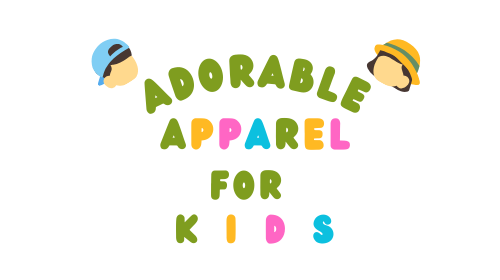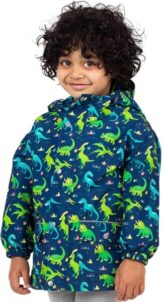
Waterproof and water-resistant might sound similar, but they’re quite different, especially when it comes to kids’ rain jackets.
Knowing the difference helps you pick the right gear for your kiddo, so let’s break it down.
Waterproof Rain Jackets
Waterproof means no water gets through. Think raincoats that stand up to the craziest downpour. These waterproof rain jackets are made with materials and seals that keep water out completely. Handy for those non-stop rainy days or splashy adventures.
Water-Resistant Rain Jackets
Water-resistant jackets, though, aren’t as tough against water. They can handle light rain or a quick drizzle but might not hold up in a heavy shower. These water-resistant jackets usually have a coating that repels water but can eventually get soaked if the rain persists.
Kids need protection from the elements, especially when they’re out playing.
Water protection keeps them dry, comfortable, and healthy, whether they’re jumping in puddles or hiking through wet paths. The right jacket can make all the difference in their outdoor fun and activities.
Material Matters: The Science Behind Waterproof and Water-Resistant Fabrics
The magic behind waterproof and water-resistant jackets lies in their materials. Each type of fabric has its own way of keeping your kid dry, so let’s break down the science a bit.
Waterproof jackets are often made with tightly woven synthetic fabrics like Gore-Tex or nylon. These materials are usually treated with a special coating to create a barrier against water. Some even have sealed seams to make sure no water can sneak through. They’re great for keeping your adventurous kid dry on those wet, rainy days.
Water-resistant jackets, on the other hand, are typically made from lighter materials like polyester or treated cotton. These jackets have a DWR (Durable Water Repellent) coating that causes water to bead up and roll off the fabric. It’s effective but not foolproof, especially in heavy rainfall.
When it comes to kids’ rain jackets, both types have their pros and cons.
Waterproof jackets offer complete protection but can be less breathable, making them a bit warmer.
Water-resistant jackets are usually lighter and more breathable, making them comfy for active play, but might not hold up in a downpour.
Choosing between these materials depends on your kid’s needs. For heavy rain and long outdoor excursions, you might want to go with a waterproof jacket.
For everyday wear and light showers, a water-resistant jacket might be the perfect fit.
Choosing The Right Jacket: Factors To Consider For Your Child’s Needs
Different weather conditions make a big difference in choosing the right jacket for your child.
For areas with frequent rain and wet weather, a fully waterproof jacket is the go-to. If you’re living somewhere with occasional rain or light showers, a water-resistant jacket might be just right.

Consider your child’s activity level into consideration. Are they the type who’ll jump into every puddle they see? A waterproof jacket is probably the way to go.
If their activities generally keep them dry with only brief exposure to rain, water-resistant could be sufficient.
- Comfort is also key.: Waterproof jackets can sometimes be less breathable, which might get uncomfortable if your kid is running around a lot. On the flip side, water-resistant jackets are usually made of lighter, more breathable fabric, which might keep them more comfortable during active play.
- Durability is important: especially with how rough and tumble kids can be. Check out reviews and look for reinforced seams or extra-strength materials that can withstand your child’s adventures.
- Budget: is always top of mind. While waterproof jackets can be pricier, consider them an investment if you expect heavy rain. Water-resistant options are typically more affordable and can be great for everyday use.
Maintenance and Care: How to Keep Your Child’s Jacket Effective

Keeping that jacket in tip-top shape is crucial for ongoing protection. First things first, always check the care label on the jacket. Each material has its own set of cleaning instructions.
For waterproof jackets, gentle washing is best. Use a mild detergent and avoid fabric softeners as they can break down the waterproof coating.
Hand wash if you can, but machine washing on a gentle cycle works too. Always hang dry to preserve the fabric properties.
Water-resistant jackets also benefit from gentle care. Avoid harsh detergents and opt for a cold wash. Again, air drying is preferable. Re-wash treatments are available to maintain that water-repellent coating.
Every now and then, reproofing your child’s jacket might be necessary. Look for spray-on or wash-in reproof products available at outdoor or sports stores.
Proper storage is key. Store the jacket in a cool, dry place when not in use. Avoid crumpling or stuffing it into small spaces, which can damage its water-repellent properties. Use hangers to help maintain its shape and readiness for the next adventure.
If you ever notice the jacket isn’t keeping your child as dry as it used to, it might be time to replace it. Over time, coatings can wear down, and seams can loosen. Keeping your child dry and happy is worth updating their gear when needed.
In Summary,
I hope this article has helped you gain some valuable insight into into the key differences between waterproof and water-resistant rain jackets for kids.
Waterproof jackets offer full protection from a downpour, while water-resistant jackets only provide a limited barrier against rain.
When choosing an appropriate rain jacket for your child, take into consideration factors such as weather conditions and activity levels, ensuring your child stays dry and comfortable.
This way, your child will be prepared when he or she heads outdoors for whatever outdoor adventure you have planned.
You May Also Like
Waterproof Vs. Water-Resistant: What To Look For In Boys Puffer Jackets
How To Choose The Perfect Fleece Lined Rain Jacket For Your Toddler Girl – Styles She’ll Love


